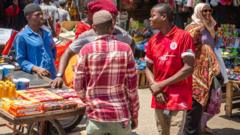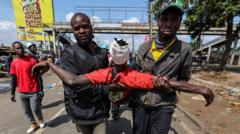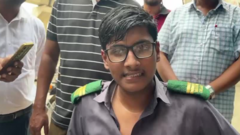Secret filming by BBC Africa Eye has revealed systemic child sexual abuse in Kenya's Maai Mahiu, where women known as "madams" exploit girls as young as 13 in prostitution. Despite the illegal nature of this trade, lack of evidence and fears from victims hinder law enforcement responses.
Undercover Investigation Reveals Child Exploitation in Kenya's Sex Trade

Undercover Investigation Reveals Child Exploitation in Kenya's Sex Trade
A harrowing BBC Africa Eye investigation uncovers the role of "madams" in the child sex trade in Kenya's Maai Mahiu, exposing vulnerable minors to exploitation.
In Maai Mahiu, a significant transit hub in Kenya's Rift Valley region, an undercover investigation has brought to light the alarming reality of child exploitation where women, referred to as "madams," are actively involved in recruiting and managing underage girls for prostitution. This investigation, conducted by BBC Africa Eye, utilized secret filming to expose the dark underbelly of a flourishing sex trade in this trucking town, which serves as a critical junction for goods and individuals moving through East Africa.
The investigation illustrates the shocking utterances of women like Nyambura, who spoke about the ease of manipulating minors with simple bribes like sweets. She acknowledges the prevalently risky environment in which she operates, sneaking underage girls out at night, yet boasts of the financial benefits derived from the exploitation of these vulnerable children. This grim revelation paints a disturbing picture of a community where prostitution has been normalized, primarily fueled by the constant flow of truck drivers seeking illicit services.
The Kenyan authorities have been informed of the findings, yet the footage gathered has not led to any arrests, with police struggling to trace the individuals involved, lacking substantial testimonies from the young victims. In a setting where talking about their experiences is fraught with fear, the minors, once again, find themselves trapped in a cycle of fear and victimization.
Moreover, the investigation highlights the murky legal landscape of prostitution in Kenya, where the act is not rigorously criminalized at the national level, allowing such operations to proliferate in areas like Maai Mahiu. The criminalization of living off the proceeds of prostitution stands as a mere guideline rather than an executable law, allowing the madams to operate with relative impunity.
Understanding the scale of this issue proves daunting; previous reports indicated thousands of children forced into sex work, but comprehensive statistics remain elusive. The nexus between sexual exploitation and widespread poverty, combined with the vulnerability that comes from familial disintegration, has left many children in dire circumstances, faced with no alternative but to engage in sex work for survival.
Witness accounts from current and former sex workers reveal harrowing tales of abuse and exploitation. One of the undercover investigators met Cheptoo, another madam, who openly discussed her profits from selling young girls, reflecting a chilling business mindset around the exploitation of children.
Adding another layer to this tragic reality is "Baby Girl," a former sex worker who now provides refuge and support to escaped minors in Maai Mahiu. With the world watching, she stresses the need for continued outreach and education in an area with high incidences of HIV, facing an impending cut in US funding that has supported vital health programs in the community.
As the investigation ends, the grim stories of defiance from the young women like Lilian, who aspire to turn their lives around, stand in stark contrast to the harsh realities they face. The urgency of addressing such abuses is palpable, but systemic barriers, fear, and ongoing funding cuts threaten to stifle hope in this vulnerable community. Whether this report will prompt action remains to be seen, but the lives of these children hang precariously in the balance.
The investigation illustrates the shocking utterances of women like Nyambura, who spoke about the ease of manipulating minors with simple bribes like sweets. She acknowledges the prevalently risky environment in which she operates, sneaking underage girls out at night, yet boasts of the financial benefits derived from the exploitation of these vulnerable children. This grim revelation paints a disturbing picture of a community where prostitution has been normalized, primarily fueled by the constant flow of truck drivers seeking illicit services.
The Kenyan authorities have been informed of the findings, yet the footage gathered has not led to any arrests, with police struggling to trace the individuals involved, lacking substantial testimonies from the young victims. In a setting where talking about their experiences is fraught with fear, the minors, once again, find themselves trapped in a cycle of fear and victimization.
Moreover, the investigation highlights the murky legal landscape of prostitution in Kenya, where the act is not rigorously criminalized at the national level, allowing such operations to proliferate in areas like Maai Mahiu. The criminalization of living off the proceeds of prostitution stands as a mere guideline rather than an executable law, allowing the madams to operate with relative impunity.
Understanding the scale of this issue proves daunting; previous reports indicated thousands of children forced into sex work, but comprehensive statistics remain elusive. The nexus between sexual exploitation and widespread poverty, combined with the vulnerability that comes from familial disintegration, has left many children in dire circumstances, faced with no alternative but to engage in sex work for survival.
Witness accounts from current and former sex workers reveal harrowing tales of abuse and exploitation. One of the undercover investigators met Cheptoo, another madam, who openly discussed her profits from selling young girls, reflecting a chilling business mindset around the exploitation of children.
Adding another layer to this tragic reality is "Baby Girl," a former sex worker who now provides refuge and support to escaped minors in Maai Mahiu. With the world watching, she stresses the need for continued outreach and education in an area with high incidences of HIV, facing an impending cut in US funding that has supported vital health programs in the community.
As the investigation ends, the grim stories of defiance from the young women like Lilian, who aspire to turn their lives around, stand in stark contrast to the harsh realities they face. The urgency of addressing such abuses is palpable, but systemic barriers, fear, and ongoing funding cuts threaten to stifle hope in this vulnerable community. Whether this report will prompt action remains to be seen, but the lives of these children hang precariously in the balance.





















